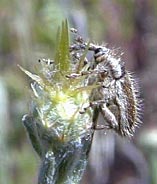Since 2002, the District has cooperated with local landowners and agencies to collect and release insects to battle yellow starthistle, spotted knapweed, and diffuse knapweed.
 All over the state of Idaho noxious weeds are invading private and public lands, destroying native habitat, and choking out desirable vegetation. In an effort to battle this growing threat, weed control workshops are held and bio-control efforts are implemented.
All over the state of Idaho noxious weeds are invading private and public lands, destroying native habitat, and choking out desirable vegetation. In an effort to battle this growing threat, weed control workshops are held and bio-control efforts are implemented.
Workshops explain the process of biological weed control. Presentations focus on the biology of the target weed, the weed’s natural predators, and how to collect and monitor insect agents.
After workshops, participants collect Eustenopus villosus (seed head weevil), photo at left, and Larinus curtus (flower weevil) to take and release on their private lands.
Workshops are held in the summer (usually June) of each year.
The District and local agencies such as the Nez Perce Tribe Bio-Control Center and the Idaho Department of Fish and Game coordinate an insect control day in June of each year. During this date, insects are collected. The collected insects are placed in release containers with 300 insects each. The District provides these insects free of charge to local landowners for release on their properties. To get on the distribution list, landowners should call the District office. Insects are usually collected and released in the last week of June or first week of July.
The District has developed a bio-control release plan which focuses on the distribution of insects in prioritized drainages. To implement this project, the District received funds from the Idaho Department of Agriculture and the Clearwater Basin Weed Management Area to collect and release insects.
Why Do We Need BioControl?
As weeds were introduced to America, by accident or as ornamental plants, their natural enemies were not brought across the ocean. With no natural predators, these weeds grow large and plentiful, choking out native plant species.
Getting Agents Here...
After years of insect collection, in-depth research, and litigation, insects have slowly been introduced in the United States to manage weed populations. This process takes anywhere from 4-7 years.
Locally efforts are underway to make these insect available to landowners. Insects for yellow starthistle, spotted/diffuse knapweed, canada thistle, rush skeleton, and dalmation toadflax are presently being raised in Lapwai, Idaho by staff at the Nez Perce Tribe Biocontrol Center and by staff at the University of Idaho in Moscow, Idaho.